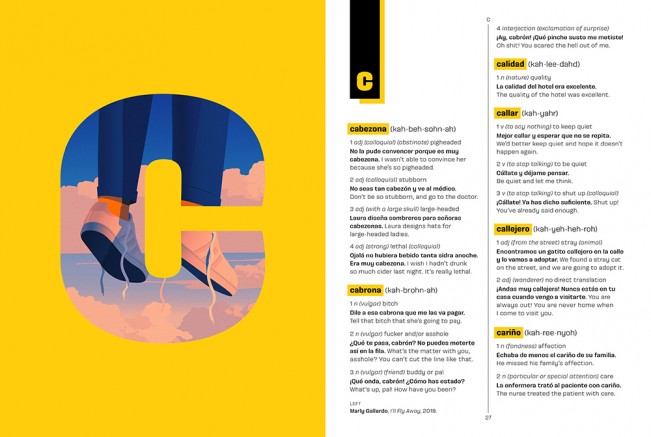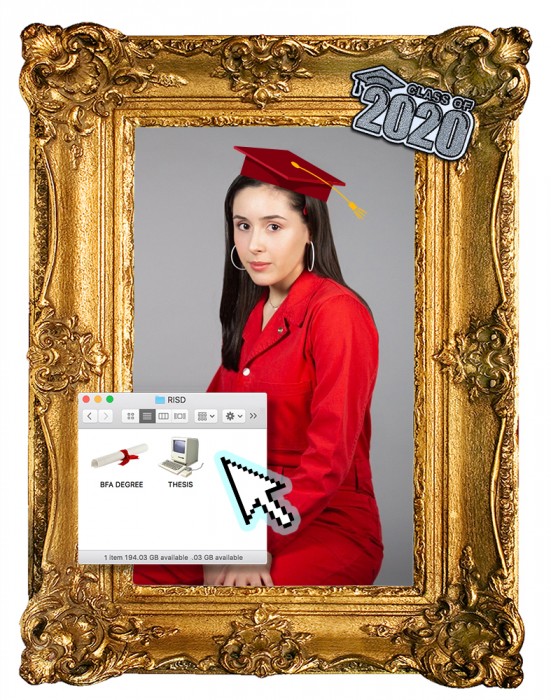Jaulas // Cages: Xiomara España
In a show of solidarity for those who are being held captive against their will, oppressed, and colonized by this authoritarian regime “Jaulas // Cages” is a week celebrating emerging Latinx Image-makers who I am interviewing to gain their insight and voice on the current danger it is to be outside the white patriarchal standard the current US government is striving for. This week is dedicated to all immigrants, and to those who do work or are currently in a jaula//cage. A cage being anything from physical, emotional, mental. These “Jaulas” are struggles we ALL have been within at points in our life: An enclosure of gender, a cage of identity, the pens of oppression, a box to be tokenized by.
Xiomara España is a designer and bookworm with a B.F.A. from the Rhode Island School of Design specializing in Graphic Design and a minor in Literary Arts and Studies. There, she immersed herself in a variety of courses in book design, web design, brand identity, package design, typography, and exploring ways to incorporate her Latin culture in hopes to inspire change.
She is currently a designer at Fathom Information Design helping develop design platforms and products for understanding data that require a clearer approach. Before joining the Fathom team , Xiomara worked as a design intern at MTV creating digital, print, and broadcast graphics while her personal work was recently featured in Paper Magazine as part of the 2020 BFA Student Show. She enjoys riso printing, darkroom photography, and cooking.
Artist Statement
While I was born and raised in Sherman Oaks, California, I grew up in a Latin household, exposed to the cultura of Mexico and Argentina. It is through language, music, and food that I have learned who I am and have come to recognize the importance of speaking Spanish and to not be ashamed. It all started when I began to have the willingness to be vulnerable and have an authentic conversation about the shared experience many American born Latinx people grapple with.
My work is a culmination of tools that I wish had existed to guide me through my early teen years when I was most vulnerable and starting to discover my Latinahood. There aren’t too many Latina designers, artists, or even famous figures in the mainstream so the works I make serve as a Latinx life raft if you will, a supplementary source. The elements I’ve designed not only illustrate my inner thoughts, but also serve as inclusive tools that debunk stereotypes and celebrate powerful Latinx role models. I’ve found that just the act of inclusion, visibility and representation can validate our experience. Visibility creates more possibilities, gives agency to young Latinx people, and broadens the depiction of our cultura.
In many cases, subconsciously or consciously, we are stripped of our Spanish tongue and Latin heritage and told it’s really important to speak English to avoid hardship. Which in a lot of ways is true because of the prejudice this country holds, but we have a choice in this matter. Rather than conform, let’s celebrate the aspects of our cultura that matter to us, that remind us of home, and keep us connected.
When you hear the word Jaulas//Cages, what are you thinking of?
I immediately think of the children who have been ripped away from their families. Just hearing the word overwhelms me with frustration, fear and anger. It’s astounding that such gross human rights violations are continuing to happen and it very much feels like history keeps repeating itself. It is so incredibly disappointing and disturbing to think of the trauma and violence inflicted on our own people all for being Latinx and labeled aliens on a land that is theirs. People need to be held accountable and we cannot continue to let things go unchecked as a country.
How would you describe your upbringing and how you came to be an artist?
My family and upbringing is the foundation for my life and my work.
I was born and raised in Los Angeles, California. Both my mamá and papá immigrated to the United States in their early 20s to work in the film industry, she from Mexico and him from Argentina. This makes my brothers and I First Generation Americans. My parents started their married life together in a house they bought in the Valley and have lived in that house ever since. We spoke Spanish at home and were encouraged and taught to speak it always.However, I attended a predominately white private school which made it difficult to combine my cultura with the American one I was surrounded by at school.
My parents have always been incredibly supportive of my creative endeavours and career and have always taught me to embrace being a woman. I think them also being in creative fields made it easier for them to understand my drive to be an artist.
My family and I have always been incredibly close. I think a big reason why we are is because our entire extended family have always lived outside of the U.S. so every holiday, birthday, or any monumental moment in my childhood have always consisted of the five of us. We only really had each other to lean on and continue celebrating our latinidad. My upbringing was also very amoroso and carinosa and that’s really due to us spending so much time together and making sure we made time to do so.
I became an artist really because of my papá. He was a photographer before he became an advertising producer and so our home even to this day is covered in his photographs. So from an early age I was aware of the camera and he even gave me my first digital point and shoot camera. By having this tool it was my first attempt at parsing together my story and showed me how art has always been a form of storytelling. This is a theme that drives my work through and through because by me creating my own images and graphics, I am creating my latinx narrative when there really aren’t many it at all present in the Westernized cannon. The power photography and art has to narrate and incite change is what drew me to becoming an artist. As a lover of language once I discovered how type + image can work as a translative tool for one’s experience and emotions I knew this was it for me.
From your upbringing and work, what does Latinidad, mean to you? Does being Latinx inform for work?
Latinidad means everything to me. It means family, community, comida rica, vibrant colors, powerful music, legacies of resistance, legacies of revolution, lineages of strong women.
It absolutely informs my work. All of my work has to do with my identity in one way or another and I constantly ask myself how can I integrate it even more whether that’s including more Spanish words or in my color choices. I truly feel that I have a duty as designer and artist to celebrate my latinidad because I’m only limiting myself by not pushing myself to do so.
Who and/or what inspires you?
My mamá is one of my greatest inspirations for her sheer kindness and confidence to never stop being herself. I find that I turn to the powerful Latinx women around me for inspiration as well including Selena Quintanilla and Jennifer Lopez. It’s these women who have shown me what drive and determination can do and I owe them so much because they paved the way for younger generations to have better opportunities.
Patti Smith, Roxane Gay, and John Waters are also some of greatest inspirations for they created from their own experience and do not let societal boxes dictate what their stories must be. Instead, they use it as fuel for their writing and storytelling.
What do you feel is your relationship to photography, and how does this inform you when you design?
I use photography as a tool to narrate and present my story whether that’s my own photography or reappropriating and recontextualizing; it’s through this form of visual language that I can communicate my own experience.
The way in which photography informs my way working is really through my creative thought process. I’ve always brainstormed in almost a snapshot way so through this way of thinking I am able to sequence my work and form the way in which I pace my books or zines for the reader.
What do you want to see more of in the art world?
I want to see more Latinx artists, designers, illustrators, and photographers in the art world. Even with four years of an arts education under my belt, I still can’t name many Latinx artists and the ones that I do know I found through my own research.
Just the act of including Latinx artists and making their work is visible is what propels change. I especially learned this during the making of my thesis which heavily emphasizes visibility as the tool in order to create that change. By me including more Spanish slang words or Latinx imagery, I can inspire other Latinx youth to feel comfortable, relate to the work, possibly inspire them to be in a creative field, and the culture will become part of their vernacular if it isn’t already. How are Latinx youth meant to learn about their culture when it barely exists in the art world?
What advice would you have for up and coming Latinx artists?
Don’t translate yourself or your work. For so long I felt the need to assimilate and edit myself to better fit into what’s “cool” or “normal” in an American society. By doing so I only become more uncomfortable and shameful of myself, speaking Spanish, and my cultura. So the biggest lesson I’ve learned is to ignore the westernized standards we are bombarded with daily and instead celebrate my latinidad any chance I get!
The other piece of advice I would give is to continue making no matter how big or small your audience may be, by making work as a Latinx artist you are providing a space for future generations.
What is next for you?
Well I currently just moved to Boston to start my first full time job so that’s been my main focus but I’ve recently been illustrating, animating, and creating gifs/stickers for a non-profit called Taskforce. Through that process I have this whole folder of scrapped designs and so I am hoping to redesign those fully en español and create a series of printable stickers with Spanish phrases and slang! So stay tuned because those stickers are in the works and will be sold soon! But yeah my main goal moving forward is to design more in Spanish and start presenting my thesis for other Latinx youth.
Follow me @xioceo Website: https://www.xioespana.com/
Posts on Lenscratch may not be reproduced without the permission of the Lenscratch staff and the photographer.
Recommended
-
Tara Sellios: Ask Now the BeastsApril 6th, 2024
-
ALEXIS MARTINO: The Collapsing Panorama April 4th, 2024
-
Emilio Rojas: On Gloria Anzaldúa’s Borderlands: The New MestizaMarch 30th, 2024
-
Artists of Türkiye: Eren SulamaciMarch 27th, 2024
-
Love and Loss in the Cosmos: Valeria Sestua In Conversation with Vicente IsaíasMarch 19th, 2024










































































